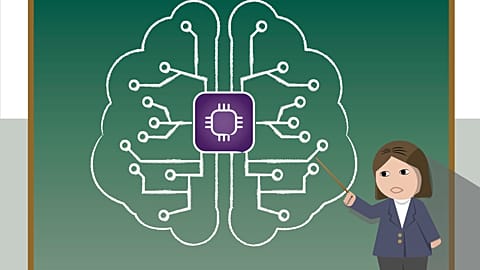Spoiler alert: The secret to a happy workplace is not free food or gym memberships.
Back in 1987, a British man named Henry Stewart launched a company called Happy Computers that offered accessible computer and management training.
Happy Computers was thriving, making information technology (IT) “fun,” and Stewart was feeling great - he had founded the firm after working at a “miserable” workplace for years.
Close to the company’s 15th anniversary, the fun suddenly took an unexpected turn. Happy Computers started winning awards for its management style.
First, it was rewarded for its great customer service and then, for five years in a row, was named one of the UK’s top 20 companies to work for.
“Clients started asking: ‘How do you do this?’” Stewart said. “So we started to develop a range of management and leadership programmes to teach Happy Computer's work philosophy to other organisations”.
The rest is history.
Today, Happy Ltd - it ditched ‘Computers’ from its name - helps senior leaders build organisations “based on trust and freedom and stepping away from decision-making,” according to Stewart.
It also offers a “Happy MBA,” a two-year senior leaders programme he says “can transform organisations”.
“It's been a long journey,” Stewart told Euronews Next. “If you talked about a happy workplace in 1987, people just pantomimed it”.
About seven years ago, Stewart even quit his role as CEO to become Happy’s Chief Happiness Officer (CHO).
“Now I'm looking around for the kind of things that will make people happier and better in the workplace,” he said.
Giving workers confidence - and trusting them
So, what does a happy workplace look like, according to Happy’s Chief Happiness Officer?
It implies building structures where the role of the manager is to coach and help teams build their confidence to work out their own solutions, Stewart explained.
“What people appreciate is being able to play to their strengths, do something they're good at, and make a difference. This is not about free food and gym memberships,” he said.
Happy also ranks as one of the world's “most democratic workplaces,” which is another key element to a thriving work culture, according to Stewart.
The idea is to lose “the command and control hierarchy,” and bring the workforce into making the decisions, he explained, “because they're the people that actually know what's going on at the front line”.
At Happy Ltd, for example, salaries - including Stewart’s - are determined by the staff.
Last year, the company was ranked the second best workplace in the UK among small and medium companies (with 20 to 50 employees) and even made it among the top 15 in Europe within the SME section. Happy also recently took part in the UK pilot of the four-day week, and has now made the scheme permanent.
“A happy workplace is ultimately about trust,” said Stewart. “I trust my people”.
Caring for workers’ mental health
There are about 5,500 Chief Happiness Officers registered on LinkedIn.
William Lin is another of them. He is the CHO at Treezor, a fintech company that was taken over by France’s third largest bank, Société Générale (SocGen), in 2018.
He became Chief Happiness Officer in 2018 after a headhunter offered him the job.
Lin’s career in the hospitality business gave him a sense of service, “which is what being a CHO is all about,” he told Euronews Next.
Looking after workers’ mental health is a big part of the job, and so is being ready to adapt to emerging needs, he said.
For Treezor, for example, the widespread adoption of remote work has meant an increased responsibility to better equip the workforce working from home, but also to create an attractive on-site environment.
“We want to motivate our teams to come to the office, so we organise events, create team building initiatives and so on,” Lin explained. “Any pretext for people to meet, exchange and connect with one another is something we believe in”.
Treezor sees a strong business case behind this position, and says companies who have not hired a Chief Happiness Officer yet should “seriously” consider it.
“If we have employees who feel bad, uncomfortable or exhausted, it will impact their performance, and ultimately the whole team’s, because they will probably communicate their discomfort,” Lin said.
“Then it can have an impact on our recruitment, the number of departures, turnover, etc.”
Employee turnover has become a significant concern for many organisations, and for good reason. In 2022, the Work Institute’s 2017 Retention Report stated that turnover can cost employers 33 per cent of an employee’s annual salary, without including indirect costs such as knowledge lost when employees leave or time spent finding a replacement.
Asking the right questions
Since he took up his new position, Lin has established a series of satisfaction surveys to follow up on the well-being of each employee.
The surveys ask questions such as ‘How do you feel about the relationship you have with your manager today?’ or ‘Do you feel you have enough tools today to maximise your work?’
All of this data is then compiled and presented to the management committee every quarter to come up with a plan addressing any of the challenges that surfaced.
Companies that want to jump on the happiness culture bandwagon must have “an honest desire to understand and improve the well-being of the employees,” Lin said.
It cannot just be “BS and politics,” he added. “This is a real mindset based on the understanding that employees are the centre of the machine”.
Turning managers into good listeners
For Anita Ruszcsak, Chief Happiness Officer at Mexican fintech Heru, building a culture of happiness in the workplace should be seen as "an approach to human resources" where managers listen more carefully to employees and develop a key skill: empathy.
“Workers who feel fulfilled will have a much better performance, will be much more committed, will have more confidence to express themselves, will be more likely to propose improvements, as well as to raise his/her hand when something is wrong,” Ruszcsak told Euronews Next.
Similar to Treezor, Heru - an automated tax solution graduate of the Y Combinator programme - has implemented one-to-one weekly sessions where managers are assigned the task of listening to their team members, on both work-related and personal matters.
Ruszcsak's team assists the managers in improving their emotional intelligence and people skills. “We give them training on what kind of questions they can ask, for example, how to react, and how to be an active listener,” she explained.
The key is creating “an environment of trust,” where there is “psychological safety and a positive communication dynamic between employees and their managers”.
Some of the questions managers can ask their staff to build this dynamic are, for example, ‘What makes you laugh?’ ‘What activities give you the most energy?’ ‘What are your goals in the next six months, 12 months from now?’ ‘And what is stopping you from reaching that?’
Ultimately, the most important question is: 'How can I help you?’”
Ruszcsak said she and her team then extensively follow up on the answers to these questions to support the managers in finding solutions, and to ensure they have “enough flexibility in budgets to address specific needs whenever it's necessary”.
It’s no surprise that the notion of trust is so prominent in discussions about a happy workplace. Trust has also been identified as a key indicator in the annual World Happiness Report.
“People are much, much happier if they feel they're in an environment where people are going to watch their back,” Professor John F. Helliwell, editor of the World Happiness Report, who has been working on happiness surveys for 25 years, told Euronews Next.
Finally, and perhaps most importantly, there is a difference between being happy and being “satisfied” at work: while the terms are often used interchangeably, they actually describe two different levels of well-being.
“Our aim is to create joy at work, which is just way beyond being satisfied, isn't it?” said Stewart.


















